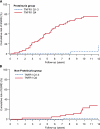Circulating TNF receptors 1 and 2 predict ESRD in type 2 diabetes
- PMID: 22266663
- PMCID: PMC3294310
- DOI: 10.1681/ASN.2011060627
Circulating TNF receptors 1 and 2 predict ESRD in type 2 diabetes
Abstract
Levels of proinflammatory cytokines associate with risk for developing type 2 diabetes but whether chronic inflammation contributes to the development of diabetic complications, such as ESRD, is unknown. In the 1990s, we recruited 410 patients with type 2 diabetes for studies of diabetic nephropathy and recorded their characteristics at enrollment. During 12 years of follow-up, 59 patients developed ESRD (17 per 1000 patient-years) and 84 patients died without ESRD (24 per 1000 patient-years). Plasma markers of systemic inflammation, endothelial dysfunction, and the TNF pathway were measured in the study entry samples. Of the examined markers, only TNF receptors 1 and 2 (TNFR1 and TNFR2) associated with risk for ESRD. These two markers were highly correlated, but ESRD associated more strongly with TNFR1. The cumulative incidence of ESRD for patients in the highest TNFR1 quartile was 54% after 12 years but only 3% for the other quartiles (P<0.001). In Cox proportional hazard analyses, TNFR1 predicted risk for ESRD even after adjustment for clinical covariates such as urinary albumin excretion. Plasma concentration of TNFR1 outperformed all tested clinical variables with regard to predicting ESRD. Concentrations of TNFRs moderately associated with death unrelated to ESRD. In conclusion, elevated concentrations of circulating TNFRs in patients with type 2 diabetes at baseline are very strong predictors of the subsequent progression to ESRD in subjects with and without proteinuria.
Figures


Comment in
-
Do we now have a prognostic biomarker for progressive diabetic nephropathy?J Am Soc Nephrol. 2012 Mar;23(3):376-7. doi: 10.1681/ASN.2012010090. Epub 2012 Feb 9. J Am Soc Nephrol. 2012. PMID: 22323641 No abstract available.
References
-
- Hotamisligil GS, Spiegelman BM: Tumor necrosis factor alpha: A key component of the obesity-diabetes link. Diabetes 43: 1271–1278, 1994 - PubMed
-
- Pickup JC, Crook MA: Is type II diabetes mellitus a disease of the innate immune system? Diabetologia 41: 1241–1248, 1998 - PubMed
-
- Pradhan AD, Manson JE, Rifai N, Buring JE, Ridker PM: C-reactive protein, interleukin 6, and risk of developing type 2 diabetes mellitus. JAMA 286: 327–334, 2001 - PubMed
-
- Spranger J, Kroke A, Mohlig M, Hoffmann K, Bergmann MM, Ristow M, Boeing H, Pfeiffer AF: Inflammatory cytokines and the risk to develop type 2 diabetes: Results of the prospective population-based European Prospective Investigation into Cancer and Nutrition (EPIC)-Potsdam Study. Diabetes 52: 812–817, 2003 - PubMed
-
- Liu S, Tinker L, Song Y, Rifai N, Bonds DE, Cook NR, Heiss G, Howard BV, Hotamisligil GS, Hu FB, Kuller LH, Manson JE: A prospective study of inflammatory cytokines and diabetes mellitus in a multiethnic cohort of postmenopausal women. Arch Intern Med 167: 1676–1685, 2007 - PubMed
Publication types
MeSH terms
Substances
Grants and funding
LinkOut - more resources
Full Text Sources
Other Literature Sources
Medical

